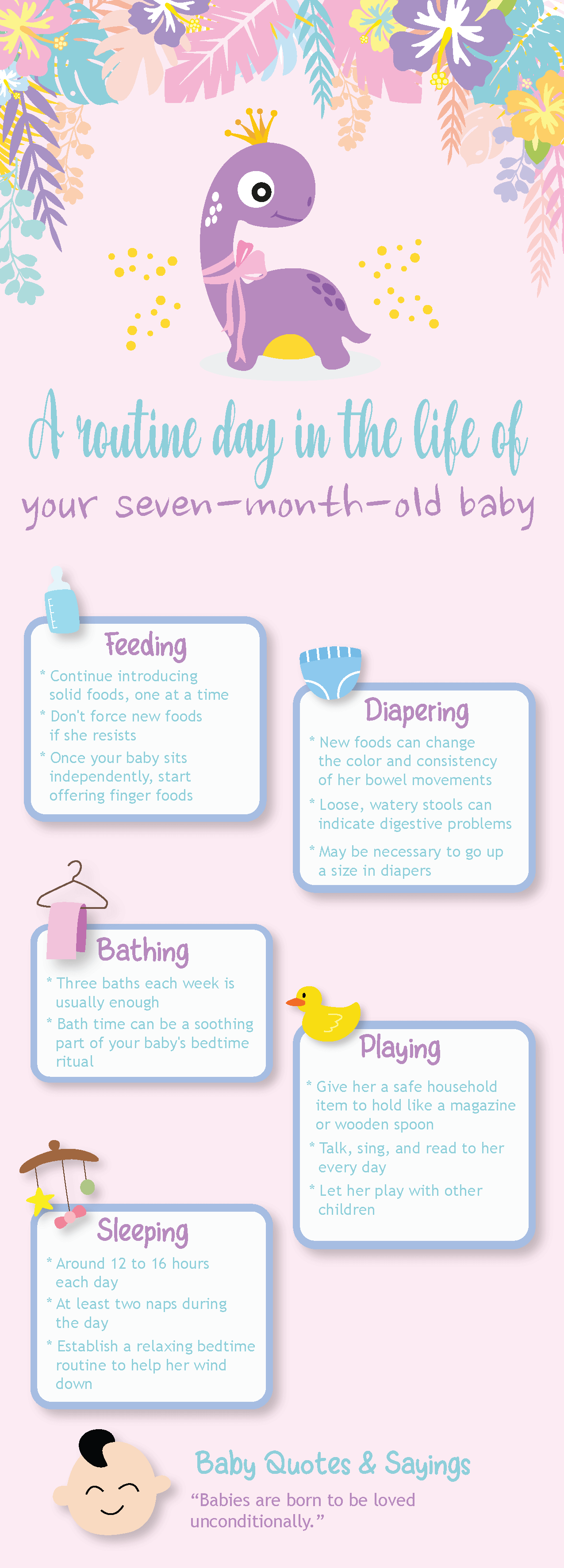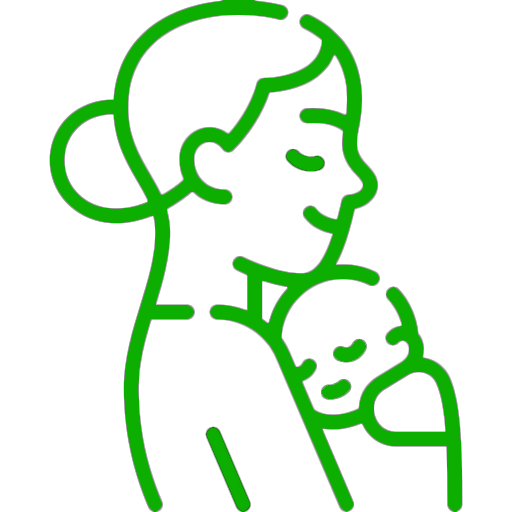Your and your Seven-Month-Old Baby’s All Thing daily existence is full of surprises and obstacles, great triumphs and small victories. Being open and flexible is essential for getting through the ups and downs together. Learn what a 7-month-old baby might be doing this month, including which developmental milestones you might see, and get some tips on how to introduce solids to your baby. We’ll also provide advice on areas like car safety and antibiotic use. Grab a cup of tea or coffee and check out what’s happening this month.

Seven-Month-Old Baby Milestones in Infant Development
Once your kid is 7 months old, there are many exciting milestones to look out for. Here are a few highlights:
Growth and Physical Development: She has gained more than double her birth weight!
This month, your baby will most likely gain another 1 to 14 pounds. She may even be 2.5 times her birth weight by the end of this month. If you take your baby in for a checkup this month, your baby’s healthcare practitioner will plot her measures on the baby growth charts to ensure that your 7-month-old baby’s weight, length, and head circumference are on track. More information regarding how baby growth charts are used may be found here.
The Imitation Game: Senses
As your baby begins to copy the sounds in your speech, you may have an especially special role to play in his or her language development beginning about this month. Encourage her efforts by talking to her frequently and repeating simple words such as “mama,” “dada,” and “dog.” Your kid will most likely notice and respond to the different tones you use. For example, raising your voice may cause her to weep, whereas speaking to her in a soothing tone may cause her to feel comfortable and stop sobbing.
Movement: More coordinated and self-sufficient
This month, one of the most noticeable changes you may notice is an improvement in your baby’s ability to coordinate her movements:
- Your child could be able to move objects from one hand to the other. As she investigates, you could see her turning items sideways and upside down.
- She can probably roll over in both directions. The majority of kids learn to roll from their stomach to their back first. You’ll have to be extra cautious now that she’s on a high surface, such as a changing table. Keep an eye on her and a hand on her!
- When your baby is sitting, she may lean forward onto her hands to support her upper body in a “tripod” stance. You might offer her a toy to focus on to help her stay balanced. Soon, she won’t need to use her arms for extra support and will be able to sit erect without assistance.
- Your baby may reach for and grab her toes while lying on her back. She’s gradually figuring out what her various body parts can do and adjusting to new experiences.
- Each baby is different, although some 7-month-olds may begin crawling.
You’ll Know When Your Baby Wants Something Thanks to Cognitive Development!
Your 7-month-old has her own personality and is becoming more capable of expressing herself. For example, your baby used to cry solely when she was hungry or uncomfortable, but now she will cry for a variety of reasons. For example, she may cry to express her desire for a different toy, her boredom and desire to do something different, or her anxiety at being held by someone new.
True, you may not always appreciate her weeping or dropping something to draw your attention. However, your kid is improving her communication skills and showing her individuality and disposition. Because everyone is different, try to figure out what works best for you and your baby. Give her something particularly comfortable before she goes to bed, for example. If she prefers some quiet time alone, go with the flow and allow her some space. Keep in mind that your child’s tastes may alter from month to month as she learns about the world and her place in it.
A Day in the Life of Your Baby
Every baby is different, but here’s a glimpse of what a typical day could look like with your baby.

the-all-thing-7-month-old-baby-your-baby
How to Support Your Baby’s Development
Seven-month-old newborns enjoy objects and toys with a variety of shapes, colours, sizes, and textures. They also enjoy things that produce noise when they are handled. Of course, you don’t have to buy your 7-month-old infant a ton of toys to stimulate her development. In reality, she might be just as interested in everyday household objects like pots and pans, wooden spoons, and bright image magazines. Simply ensure that whatever she wants to handle is safe and that you supervise her while she is playing.
Talking and reading to your baby, listening to and responding to her babbles, and taking her on walks or other trips are all excellent methods for her to learn and grow. You might also sing to your infant or dance with her while listening to music. Feel free to utilize a foreign language with her if you are fluent in one.
As your baby becomes more mobile, make sure she has a safe place to explore. You could, for example, build up a playpen where she can have supervised playtime.
How to Feed Your 7-Month-Old Baby
You can begin introducing solids to your infant around this time. Here are some pointers and insights on how to gradually incorporate this into your baby’s diet:
- Solids are only a supplement at this point; your baby’s nutritional needs are still mostly satisfied by breast milk and/or formula. The goal now is just to teach her how to consume food with a spoon. Expect most of the food to end up on her face, bib, or the floor.
- Use a little spoon and start with half a tablespoon of food or less.
- Ascertain that your infant is sitting upright, such as in your lap or a high chair.
- Select a moment when your infant is not exhausted, irritable, or ravenous..
- Try offering the spoon after a short period of breastfeeding or bottle feeding. This helps her associate spoon feeding with the soothing sensation of nursing.
- Your 7-month-old should be fed single grain cereals combined with formula, breast milk, or water, as well as pureed vegetables or fruits. It’s recommended to introduce one new food at a time for a few days so you can monitor for any allergic responses.
- If you want to prepare your own baby food, mash fruits and vegetables with a food processor, blender, or even a fork. Simply ensure that the meal is well cooked, tender, and unseasoned – no salt included.
- Keep in mind that your kid may not be ready for solids yet and may attempt to demonstrate this to you. For example, if your baby turns away or begins sobbing when you attempt to feed her a scoop of puree, it may be preferable to abandon the attempt for the time being and try again in a few days or weeks.
- When your baby is able to sit up on her own, you can start giving her finger foods so she can try to feed herself. Small chunks of soft sweet potato, chicken, or whole-grain crackers are also good options.
- Given that each scenario is different, consult with your baby’s healthcare professional to determine whether she requires vitamin D or iron supplements as part of her diet.
How Much Baby Food Should You Feed Your 7-Month-Old?
Your baby will still be learning how to take little bits of solid food from a spoon over the next few weeks and months, so keep nursing and/or bottle-feeding at the same rate you have been. At this point, hardly much solid food will wind up in your baby’s mouth, as this is primarily about gradually introducing the spoon and some new flavours and sensations. It’s always a good idea to consult with your baby’s healthcare practitioner to ensure that her nutritional needs are satisfied and that her growth is on track. If you are concerned about overfeeding, see your doctor before adjusting your baby’s food intake.
How Solids Might Affect Your Baby’s Poop
When you begin giving your baby food, you may notice a difference in the colour and consistency of her excrement. It could get more solid and stinky! If you see particularly loose, watery stools, contact your baby’s healthcare practitioner, who will investigate what is causing your child’s digestive tract to be irritated.
This page is based on professional advice from reputable medical and government organizations, such as the American Academy of Pediatrics and the American College of Obstetricians and Gynecologists. This page’s material should not be used in place of professional medical advice. For a complete diagnosis and treatment, always seek the advice of a medical expert.














Leave a Reply
View Comments